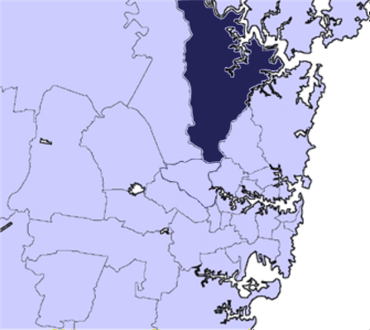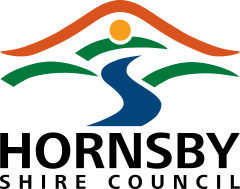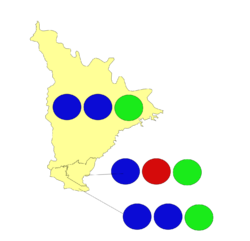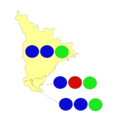Hornsby Shire facts for kids
Quick facts for kids Hornsby ShireNew South Wales |
|||||||||||||||
|---|---|---|---|---|---|---|---|---|---|---|---|---|---|---|---|

Location in Metropolitan Sydney
|
|||||||||||||||
| Population | 151,811 (2021 census) | ||||||||||||||
| • Density | 333.7/km2 (864/sq mi) | ||||||||||||||
| Established | 6 March 1906 | ||||||||||||||
| Area | 455 km2 (175.7 sq mi) | ||||||||||||||
| Mayor | Philip Ruddock (Liberal) | ||||||||||||||
| Council seat | Hornsby | ||||||||||||||
| Region | Metropolitan Sydney | ||||||||||||||
| State electorate(s) |
|
||||||||||||||
| Federal Division(s) | |||||||||||||||
 |
|||||||||||||||
| Website | Hornsby Shire | ||||||||||||||
|
|||||||||||||||
Hornsby Shire is a special area in New South Wales, Australia, that has its own local government. It's located north of Sydney, stretching from the M2 Hills Motorway all the way up to the Hawkesbury River. This makes it the biggest local government area in Greater Sydney!
As of 2021, about 151,811 people live here. The current mayor of Hornsby Shire is Philip Ruddock. He is a member of the Liberal Party and was elected in 2017.
Contents
Who Lives in Hornsby Shire?
Let's look at the people who call Hornsby Shire home. In 2016, there were about 142,667 people living here. Slightly more than half were female (51.2%), and 48.8% were male.
- Only a small number of people (0.5%) were Aboriginal and Torres Strait Islander people. This is lower than the average for New South Wales and Australia.
- The average age of people in Hornsby Shire was 40 years old. This is a little older than the national average of 38 years.
- About 19.5% of the population were children aged 0 to 14 years.
- Around 16.2% of the population were people aged 65 years and older.
Most adults (58.8%) in Hornsby Shire were married. Only a small number (8.2%) were divorced or separated.
Changes in Population and Income
The number of people living in Hornsby Shire has changed over time.
- Between 2001 and 2006, the population grew by 4.58%.
- From 2006 to 2011, it grew by another 3.65%.
- However, in 2016, the population actually went down by 9.04%. This happened because some of the shire's boundaries were changed.
People in Hornsby Shire generally earn more money than the national average. The average weekly income for a household here is higher than in many other parts of Australia.
Cultural Background and Languages
Hornsby Shire is a diverse place! Many people have different cultural backgrounds.
- The top ancestries reported are English, Australian, and Chinese.
- Besides English, the most common languages spoken at home are Mandarin, Cantonese, Korean, and Hindi.
Religious Beliefs
Like many places in Australia, more people in Hornsby Shire are choosing to say they have "No religion."
- In 2016, 28.9% of people said they had no religion.
- By 2021, this number grew to 36.0%.
- Other common religions include Catholic, Anglican, and Hinduism.
How Hornsby Shire is Governed
The Hornsby Shire is run by the Hornsby Shire Council. This council is made up of ten councillors, including the mayor. They are elected for a four-year term.
The mayor is chosen directly by the people who live in the shire. The other nine councillors are elected from three different areas called "wards." Each ward chooses three councillors.
Current Council Members
The most recent election was in December 2021. Here's how the council looks:
- Liberal Party: 6 councillors
- The Greens: 3 councillors
- Australian Labor Party: 1 councillor
- Total: 10 councillors
The current mayor is Philip Ruddock from the Liberal Party.
Past Leaders of Hornsby Shire
Hornsby Shire's History
Hornsby Shire is on the traditional lands of the Darug and Kuringgai Indigenous Australian peoples. Even though Europeans first explored the Hawkesbury River area in 1788, it took almost 50 years for people to start settling permanently because the land was so rugged.
The name "Hornsby Shire" comes from the town of Hornsby. This town was named after Samuel Horne, a former convict who became a Constable (like a police officer). He became famous for catching two bushrangers (outlaws) in 1830. Because of this, he was given land in the area, which became known as "Hornsby Place."
For many years, Hornsby Shire was mostly rural, meaning it had lots of farms and open land. When the Main North railway line was built in the 1880s, it connected the shire to Sydney and Newcastle. However, it wasn't until cars became common in the 1950s that the southern part of the shire really became part of Sydney's suburbs. The shire officially became a local government area on March 6, 1906.
In 2015, the government looked at changing local council boundaries. There were ideas to merge parts of Hornsby Shire with other councils. In the end, some southern suburbs of Hornsby Shire, like Epping and Carlingford, joined the Parramatta City Council. However, plans to force a merger between Hornsby and Ku-ring-gai councils were stopped in 2017.
Historic Places in Hornsby Shire
Hornsby Shire has several places that are listed for their historical importance. These are called heritage-listed sites. They include:
- Brooklyn, Main Northern railway: Hawkesbury River railway station
- Cheltenham, 67 Cobran Road: Ahimsa (a house)
- Galston, 161 Main Road: Tunks Creek Bridge
- Galston, 11 School Road: Galston Congregational Church Pipe Organ
- Hornsby, 2a Manor Road (Rosamond Street): Mount Wilga House
- Hornsby, Old Man's Valley, off Quarry Road: Old Man's Valley Cemetery
- Normanhurst, 82-84 Pennant Hills Road: Gilligaloola (a house)
- Wahroonga, 9 Highlands Avenue: Highlands (a house)
Geography and Nature
Hornsby Shire is often called the 'Bushland Shire'. This is because a large part of it (up to 70%) is natural bushland.
- On the eastern side, you'll find the Ku-ring-gai Chase National Park.
- On the western side, there's the Berowra Valley Regional Park.
These parks create a huge "green belt" that stretches from Sydney all the way to the Hawkesbury River in the north. They are very popular for outdoor activities like bushwalking and boating.
Different Areas of the Shire
- Northern Half: This part of Hornsby Shire is still mostly rural. It has farms, market gardens, and small villages like Mount Colah and Hornsby Heights. The village of Galston is the main hub for this rural area.
- Western Part: This area shares a 53-kilometer border with The Hills Shire. It's separated from the rest of Hornsby Shire by national parks and the Galston Gorge.
- Southern Half: This is the urban part of the shire, meaning it's where most of the suburbs are. Traditionally, people lived in separate houses here. However, more recently, you can see apartments and townhouses, especially around the main business area of Hornsby.
Hornsby Shire also has areas with industrial businesses, including Hornsby, Asquith, and Thornleigh. The main shopping and business centers, apart from Hornsby, are Pennant Hills and North Epping.
Fun Places to Visit
There are many cool places to visit in Hornsby Shire:
- The beautiful wilderness areas, including part of the Great North Walk.
- Parks like Fagan Park at Galston and Pennant Hills Park.
- The Koala Park Sanctuary in West Pennant Hills, where you can see native Australian animals.
- The charming village of Brooklyn on the Hawkesbury River.
The shire also has four public libraries (in Hornsby, Pennant Hills, Berowra, and Galston), two public swimming pools ("Aquatic Centres"), and many other sports and community facilities.
Images for kids





